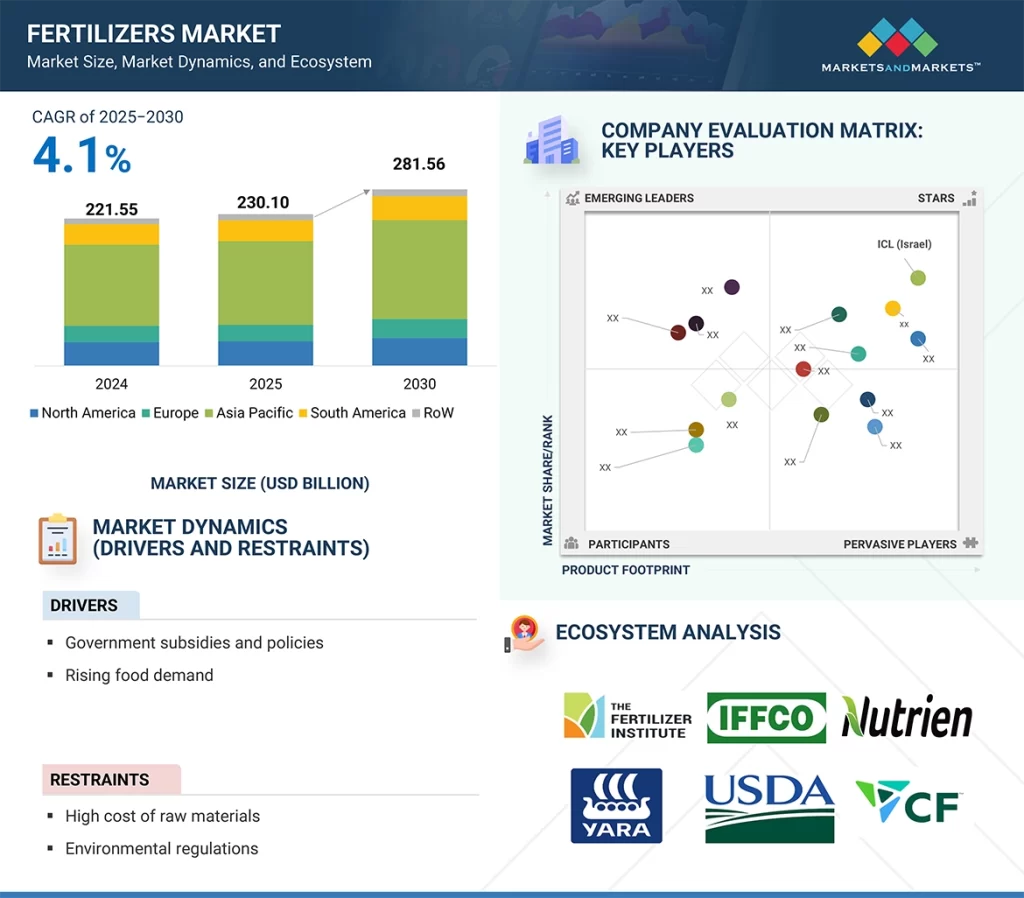The global fertilizers market is valued at USD 230.10 billion in 2025 and is projected to reach USD 281.56 billion by 2030, growing at a CAGR of 4.1% during the forecast period. Key drivers include rising global food demand, shrinking arable land, deteriorating soil quality, and increased adoption of biofertilizers. Supportive government policies and subsidies—particularly in countries like India, China, and the U.S.—further stimulate market growth. Technological advancements in precision agriculture, controlled-release fertilizers, and sustainable practices are also enhancing nutrient efficiency. Growing awareness around soil health and environmental sustainability is accelerating the shift toward eco-friendly, high-efficiency fertilizers.

- Increasing Population and Food Demand: The global population continues to grow, which drives the need for enhanced agricultural productivity. Fertilizers are essential for achieving high crop yields, especially in regions with limited arable land.
- Technological Advancements: Innovations in fertilizer manufacturing processes, such as slow-release and controlled-release fertilizers, are improving efficiency and reducing environmental impact. Smart farming technologies that utilize sensors, drones, and data analytics are also helping optimize fertilizer application, thereby increasing crop yields and minimizing waste.
- Sustainability and Environmental Concerns: With the rising awareness about the environmental impact of chemical fertilizers, the market has seen a shift toward organic and eco-friendly fertilizers. Bio-based fertilizers, derived from natural sources like animal manure, compost, and plant residues, are gaining popularity as alternatives to traditional synthetic fertilizers.
- Government Initiatives and Policies: Governments across the world are implementing policies to promote sustainable agricultural practices, including subsidies and incentives for fertilizer use. In developing countries, governments often provide farmers with financial assistance to make fertilizers more accessible.
Chemical Fertilizers: Secondary Macronutrients Lead
Within the chemical fertilizers category, secondary macronutrients hold a significant market share due to their critical role in promoting soil fertility and plant health. Nutrients such as calcium (Ca), magnesium (Mg), and sulfur (S) aid in enzyme activation, chlorophyll production, and nutrient uptake. As intensive farming depletes these nutrients, demand for secondary macronutrient fertilizers is rising. Key industry players are responding with innovative products—ICL’s Nova Calcium provides water-soluble calcium nitrate, Nutrien’s EzyFlow Nano Magnesium addresses magnesium deficiencies, and K+S Aktiengesellschaft’s soluCN enhances calcium absorption in crops.
Download PDF Brochure: https://www.marketsandmarkets.com/pdfdownloadNew.asp?id=114997228
Fertigation: A Leading Application Method
Fertigation represents a major share of the fertilizers market by application method, thanks to its efficiency in delivering nutrients directly to plant roots via irrigation systems. This technique allows precise nutrient application, reducing waste and maximizing uptake. Especially effective in water-scarce regions, fertigation, through drip and sprinkler systems, improves water and fertilizer use while boosting crop yields. Its growing use in high-value crop production, such as fruits, vegetables, and greenhouse farming, underscores its market relevance.
Regional Outlook: North America at the Forefront
North America commands a significant share of the global fertilizers market, driven by large-scale commercial agriculture, advanced agri-tech, and robust fertilizer application. The U.S. and Canada lead with intensive cultivation of nutrient-demanding crops like wheat, corn, and soybeans. The region benefits from advanced distribution networks, precision farming practices, and government support for agricultural innovation. Increasing adoption of biofertilizers, controlled-release solutions, and fertigation systems further strengthens the market. Additionally, a strong focus on soil health and sustainability is fueling demand for high-efficiency and micronutrient-enriched fertilizers, reinforcing North America’s leadership position.
Leading Fertilizers Companies:
The report profiles key players such as ICL (Israel), Yara (Norway), K+S Aktiengesellschaft (Germany), Nutrien (Canada), Mosaic (US), CF Industries Holdings, Inc. (US), Grupa Azoty (Poland), SQM S.A. (Chile), OCP (Morocco), Syngenta Group (Switzerland), Saudi Basic Industries Corporation (Saudi Arabia), Koch IP Holdings, LLC (US), Haifa Negev Technologies LTD (Israel), EuroChem Group (Switzerland), and Lallemand Inc. (Canada).

